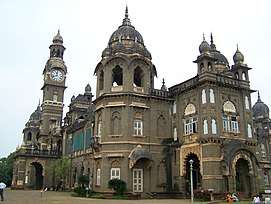History of Maharashtra
Maharashtra is a state in the western region of India. It is India's second-most populous state and third-largest state by area, and includes the major cities of Mumbai, Pune, Nashik and Nagpur. The region that comprises the state has a long history dating back to the 4th century BCE, although the present-day state was not established until 1960 CE.
| Outline of South Asian history | ||||||||||||||||||||||||||||||||||||||||||||
|---|---|---|---|---|---|---|---|---|---|---|---|---|---|---|---|---|---|---|---|---|---|---|---|---|---|---|---|---|---|---|---|---|---|---|---|---|---|---|---|---|---|---|---|---|
_without_national_boundaries.svg.png) | ||||||||||||||||||||||||||||||||||||||||||||
|
Palaeolithic (2,500,000–250,000 BC) |
||||||||||||||||||||||||||||||||||||||||||||
|
Neolithic (10,800–3300 BC)
|
||||||||||||||||||||||||||||||||||||||||||||
|
Chalcolithic (3500–1500 BC)
|
||||||||||||||||||||||||||||||||||||||||||||
|
Bronze Age (3300–1300 BC)
|
||||||||||||||||||||||||||||||||||||||||||||
|
Iron Age (1500–200 BC)
|
||||||||||||||||||||||||||||||||||||||||||||
|
Middle Kingdoms (230 BC – AD 1206) |
||||||||||||||||||||||||||||||||||||||||||||
|
Late medieval period (1206–1526)
|
||||||||||||||||||||||||||||||||||||||||||||
|
Early modern period (1526–1858)
|
||||||||||||||||||||||||||||||||||||||||||||
|
Colonial states (1510–1961)
|
||||||||||||||||||||||||||||||||||||||||||||
|
Periods of Sri Lanka
|
||||||||||||||||||||||||||||||||||||||||||||
|
Specialised histories |
||||||||||||||||||||||||||||||||||||||||||||
From the 4th century BCE until 875, Maharashtri Prakrit and its Apabhraṃśas (dialects) were the dominant languages of the region. The Marathi language, which evolved from Maharashtri Prakrit, has been the common language from the 9th century. The oldest stone inscriptions in the Marathi language date to around 975 AD,[1] and can be seen at Shravanabelgola in modern-day Karnataka at the foot of the Bahubali Statue.
Maharashtra was historically the name of a region which consisted of Aparanta, Vidarbha, Mulak, Assaka (Ashmaka) and Kuntala. Tribal communities of Bhil people inhabited this area, also known as Dandakaranya, in ancient times. There was also an ancient race called "Rattha" (रठ्ठ in Marathi), who referred to themselves as "Maharattha" (Maha is Great). The name Maharashtra first appeared in the 7th century in the account of a contemporary Chinese traveler, Huan Tsang.
In the early modern period, the region of Maharashtra came under the rule of several Islamic dynasties, including the Deccan Sultanates and Mughal Empire. For part of 17th century and most of 18th century, the region became a base for the Maratha Empire, which conquered large parts of India before being defeated by the British.
The British ruled parts of Maharashtra for more than a century until 1947. After independence from the British, the state of Maharashtra was formed in 1960 after a prolonged campaign to create a Marathi speaking state in the 1950s.
Early history

Chalcolithic sites belonging to the Jorwe culture (ca. 1300–700 BCE) have been discovered throughout the state.[2][3] The largest settlement discovered of the culture is at Daimabad, which had a mud fortification during this period, as well as an elliptical temple with fire pits. Some settlements show evidence of planning in the layout of rectangular houses and streets or lanes.[4][5] Maharashtra region later became part of the Maurya Empire with edicts of emperor Ashoka found in the region. Buddhism flourished during this period in the region.trade including international trade with Greeks and later with the Roman empire also flourished with Traders being the main patrons of Buddhist monasteries.[6][7][8] Indo-Scythians Western Satraps ruled part of the region during the early part of the first millennium.[9]
Middle Kingdoms (3rd-13th centuries CE)
The region that is present-day Maharashtra has formed part of a number of states, including the Maurya empire, Satavahana dynasty, the Kadamba dynasty, the Vakataka dynasty, the Chalukya dynasty and the Rashtrakuta dynasty. Most of these empires extended over large swathes of Indian territory. Some of the greatest monuments in Maharashtra, such as the Ajantha and Ellora caves, were built during the time of these empires.
Maharashtra was ruled by the Maurya Empire in the 4th and 3rd century BCE. Around 230 BCE it was taken over by the Satavahana dynasty which ruled the region for 400 years.[10] A notable ruler of the Satavahana Dynasty was Gautamiputra Satakarni, who defeated Scythian invaders. The Vakataka dynasty ruled from approximately 250 to 470 CE.
The Satavahana dynasty mainly used the Prakrit language,[11] while the Vakataka dynasty used both Prakrit and Sanskrit..
The Chalukya and Rashtrakuta

From the 6th century CE to the 8th century, the Chalukya dynasty ruled Maharashtra. Two prominent rulers were Pulakeshin II, who defeated the north Indian Emperor Harsha, and Vikramaditya II, who defeated Arab invaders in the 8th century. The Rashtrakuta Dynasty ruled Maharashtra from the 8th to the 10th century.[12] The Arab traveler Sulaiman called the ruler of the Rashtrakuta Dynasty (Amoghavarsha) "one of the 4 great kings of the world".[13] The Chalukya dynasty and Rashtrakuta Dynasty had their capitals in modern-day Karnataka and used Kannada and Sanskrit as court languages.
From the early 11th century to the 12th century the Deccan Plateau, including a large part of Maharashtra, was dominated by the Western Chalukya Empire and the Chola dynasty.[14] Several battles over the Deccan Plateau were fought between these empires during the reigns of Raja Raja Chola I, Rajendra Chola I, Jayasimha II, Someshvara I and Vikramaditya VI.[15]
Between 800 and 1200 CE, parts of Western Maharashtra including the Konkan region of Maharashtra were ruled by different Shilahara houses based in North Konkan South Konkan and Kolhapur respectively.[16] At different periods in their history, the Shilaharas served as the vassals of either the Rashtrakutas or the Chalukyas.
Yadav dynasty 12th-14th century
The Yadavas of Devagiri dynasty at its peak ruled a kingdom stretching from the Tungabhadra to the Narmada rivers, including present-day Maharashtra, north Karnataka and parts of Madhya Pradesh. Its capital was at Devagiri (present-day Daulatabad in modern Maharashtra). The Yadavas initially ruled as feudatories of the Western Chalukyas.[17]
The founder of the Suena dynasty was Dridhaprahara, the son of Subahu. It is unclear where his capital was located; some argue that his capital was Shrinagara, while an early inscription suggests that Chandradityapura (modern Chandwad in the Nasik district) was the capital.[18] The name Seuna comes from Dridhaprahara's son, Seunachandra, who originally ruled a region called Seunadesha (present-day Khandesh). Bhillama II, a later ruler in the dynasty, assisted Tailapa II in his war with the Paramara king Munja. Seunachandra II helped Vikramaditya VI in gaining his throne.
Around the middle of the 12th century, as Chalukya power waned, the Yadavas declared independence. Their rule reached its peak under Singhana II. The Yadavas of Devagiri used Marathi as their court language.[19][20][21] Kannada may also have been a court language during Seunachandra's rule. The Yadava capital Devagiri became a magnet for learned scholars in Marathi to showcase and find patronage for their skills. The origin and growth of Marathi literature is directly linked with the rise of the Yadava dynasty.[22]
According to scholars such as George Moraes,[23] V. K. Rajwade, C. V. Vaidya, A.S. Altekar, D. R. Bhandarkar, and J. Duncan M. Derrett,[24] the Seuna rulers were of Maratha descent.[19] Digambar Balkrishna Mokashi noted that the Yadava dynasty "seems to be the first true Maratha empire".[25]
Medieval and Early modern period (1206-1858 CE)
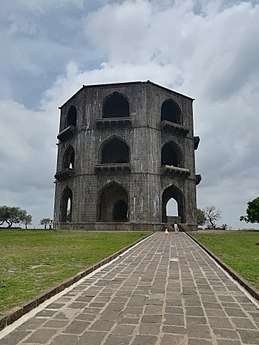
In the early 14th century, the Yadava dynasty, which ruled most of present-day Maharashtra, was overthrown by the Delhi Sultanate ruler Ala-ud-din Khalji. Later, Muhammad bin Tughluq conquered parts of the Deccan, and temporarily shifted his capital from Delhi to Daulatabad in Maharashtra.
Bahmani and Deccan Sultanates
After the collapse of the Tughluqs in 1347, the breakaway Bahmani Sultanate governed the region as well as the wider Deccan region for the next 150 years from Gulbarga and later from Bidar .[26] The early period of Islamic rule saw atrocities such as imposition of Jiziya tax on non-Muslims, temple destruction and forcible conversions.[27][28] Eventually these incidents largely ceased. For most of this period Brahmins were in charge of accounts, whereas revenue collection was in the hands of Marathas who had watans (hereditary rights) of patilki (revenue collection at village level) and deshmukhi ( revenue collection over a larger area). A number of families such as Bhosale, Shirke, Ghorpade, Jadhav, More, Mahadik, Ghatge and Nimbalkar loyally served different sultans at different periods in time.[29] Since most of the population was Hindu and spoke Marathi, even sultans such as Ibrahim Adil Shah I adopted Marathi as the court language, for administration and record keeping.[30][31][32]
After the break-up of the Bahamani sultanate in 1518, the Maharashtra region was split between five Deccan Sultanates: Nizamshah of Ahmednagar, Adilshah of Bijapur, Qutubshah of Golkonda, Bidarshah of Bidar and Imadshah of Elichpur.[30] These kingdoms often fought with each other. United, they decisively defeated the Vijayanagara Empire of the south in 1565.[33] The present area of Mumbai was ruled by the Sultanate of Gujarat before its capture by Portugal in 1535. The Faruqi dynasty ruled the Khandesh region between 1382 and 1601 before finally being annexed by the Mughal Empire. The Mughals under Akbar started capturing territories held by the Deccan sultanates towards the end of 16th century.This policy continued under his successors for almost a century when most of the present day area of Maharashtra came under Mughal control.[34] However, the Mughal control was challenged multiple times during this period.Early in the century the resistance was led by Malik Ambar, the regent of the Nizamshahi dynasty of Ahmednagar from 1607 to 1626.[35]He increased the strength and power of Murtaza Nizam Shah II and raised a large army. Malik Ambar was a proponent of guerilla warfare in the Deccan region, and was considered a great foe by Mughal emperor Jehangir.[36] He assisted Mughal prince Khurram (later emperor Shah Jahan) in his struggle against his stepmother, Nur Jahan, who had ambitions to secure the Delhi throne for her son-in-law.[37] In the second half of the 17th century, the Mughals were constantly challenged by the Marathas under Shivaji, and later his successors.[38]
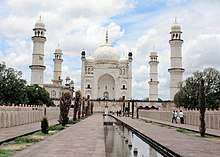
In fact, the decline of Islamic rule in Deccan started when Shivaji annexed a portion of the Bijapur Sultanate in the second half of the 17th century.In the process he became a symbol of Hindu resistance and self-rule.[39] [40]
Maratha Empire (1674–1818 CE)
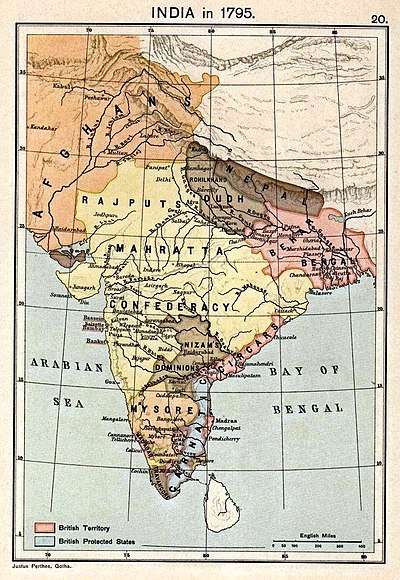
The Maratha Empire dominated the political scene in India from the middle of the 17th century to the early 19th century.
Chhatrapati Shivaji Maharaj

Chhatrapati Shivaji Maharaj was the founder of the modern Marathi empire; his policies were instrumental in forging a distinct identity for the Marathi-speaking people. He was born Shivaji Bhosale as a member of the Bhonsle clan, sometime in the period 1627 to 1630.[41] Shivaji first carved out an enclave from the declining Adilshahi sultanate of Bijapur that formed the genesis of the Maratha Empire. In 1674, he was formally crowned as the Chhatrapati (Monarch) of his realm at Raigad. However, to achieve this he not only had to fight the Mughals and the Adilshahi but also many Maratha Watandars.These Watandars considered their watan a source of economic power and pride and were reluctant to part with it. The Watandars even initially opposed the emergence of Shivaji, because their economic interests were affected.[30] Shivaji was an able administrator and established a government that included such modern concepts as a cabinet (ashtapradhana mandala), foreign affairs (dabir) and internal intelligence. He established an effective civil and military administration, built a powerful navy and erected new forts (e.g. Sindhudurg) and strengthened old ones (e.g. Vijayadurg) on the west coast of Maharashtra. He died around 3 April 1680, of dysentery.[42]
After Shivaji died, Mughal emperor Aurangzeb launched an attack on the Marathas that led to a war lasting 27 years.[43] The death of Aurangzeb in 1707 ended the war and initiated the decline of the Mughal Empire.
Expansion of Maratha Influence in 18th Century under Shahu I and Peshwa rule
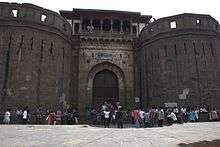
During much of the 18th century, the Peshwas, belonging to the (Bhat) Deshmukh Marathi Chitpavan Brahmin family, controlled the Maratha army and later became the hereditary heads of the Maratha Empire from 1749 to 1818.[44] During their reign, the Maratha empire reached its zenith in 1760, dominating most of the Indian subcontinent.[45][46][47][48] Bajirao I, a prominent Peshwa (general), was only 20 when appointed Peshwa. For his campaigns in North India, he actively promoted young leaders of his own age such as Ranoji Shinde, Malharrao Holkar, the Puar brothers and Pilaji Gaekwad. These leaders also did not come from the traditional aristocratic families of Maharashtra.[49] All the young leaders chosen by Bajirao I or their descendants later became rulers in their own right during the Maratha Confederacy era. Historian K.K. Datta argues that Bajirao I "may very well be regarded as the second founder of the Maratha Empire".[50]
Another general, Raghoji Bhonsle, also expanded the Maratha rule in central and East India and took control of the Nagpur Kingdom.[51] In 1737, the Marathas defeated a Mughal army in their capital, in the Battle of Delhi. The Marathas continued their military campaigns against the Mughals, Nizam, Nawab of Bengal and the Durrani Empire to further extend their boundaries.
By 1760, the domain of the Marathas stretched across most of the Indian subcontinent.[52] The Marathas even discussed abolishing the Mughal throne and placing Vishwasrao Peshwa on the Mughal imperial throne in Delhi.[53] At its peak, the empire stretched from Tamil Nadu[54] in the south, to Peshawar (modern-day Khyber Pakhtunkhwa, Pakistan[55] [note 1]) in the north, and Bengal in the east. The Northwestern expansion of the Marathas was stopped after the Third Battle of Panipat (1761). However, the Maratha authority in the north was re-established within a decade under Peshwa Madhavrao I.[57] Under Madhavrao I, the strongest knights were granted semi-autonomy, creating a confederacy of Maratha states led by the Gaekwads of Baroda, the Holkars of Indore and Malwa, the Scindias of Gwalior and Ujjain, the Bhonsales of Nagpur and the Puars of Dhar and Dewas.
In 1775, the East India Company intervened in a Peshwa family succession struggle in Pune, leading to the First Anglo-Maratha War, which resulted in a Maratha victory.[58]
Maratha Navy
Shivaji developed a potent Naval force during his rule. In the early part of the 1700s, under the leadership of Kanhoji Angre, this navy dominated the territorial waters of the western coast of India from Bilimora, Gujarat[59] to Savantwadi.[60] It attacked British, Portuguese, Dutch, and Siddi Naval ships and kept a check on their naval ambitions. The Maratha Navy was dominant in the area until around the 1730s, was in a state of decline by the 1770s, and ceased to exist by 1818.[61]
Revenue system and Chauth
One of the tools of the empire was collection of Chauth or 25% of the revenue from states that submitted to Maratha power. The Marathas also had an elaborate land revenue system which was retained by the British East India Company when they gained control of Maratha territory.[62]
British Colonial period (1818–1947 CE)
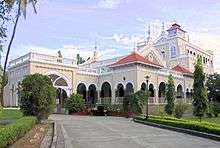
Company Rule
The East India Company controlled Mumbai beginning in the 17th century, and used it as one of their main trading posts. The Company slowly expanded areas under its rule during the 18th century. Their conquest of Maharashtra was completed in 1818 with the defeat of Peshwa Bajirao II in the Third Anglo-Maratha War.[63]
British Raj
The British ruled for more than a century and brought huge changes in every aspect of life for the people of the Maharashtra region. Areas that correspond to present day Maharashtra were under direct or indirect British rule, first under the East India Company and then, from 1858, under the British crown. During this era the Maharashtra region era was divided into the Bombay presidency, Berar, Central provinces, Hyderabad state and various Princely states such as Kolhapur and Miraj.
The British colonial period saw standardization of Marathi grammar through the efforts of the Christian missionary William Carey. Carey also published the first dictionary of Marathi in devanagari script. The most comprehensive Marathi-English dictionary was compiled by Captain James Thomas Molesworth and Major Thomas Candy in 1831. The book is still in print nearly two centuries after its publication.[64][65] Molesworth also worked on standardizing Marathi. He used Brahmins of Pune for this task and adopted the Sanskrit-dominated dialect spoken by this caste in the city as the standard dialect for Marathi.[66][67]
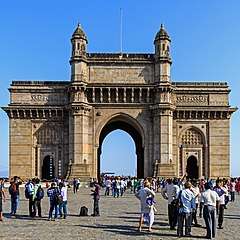
People from Maharashtra played an important part in the social and religious reform movements as well as the nationalist movement of the late 19th and early 20th centuries. Notable Civil society bodies founded by Marathi leaders during 19th century include the Poona Sarvajanik Sabha, the Prarthana Samaj, the Arya Mahila Samaj and the Satya Shodhak Samaj. The Sarvajanik Sabha took an active part in relief efforts during the famine of 1875–76, and is considered the forerunner of the Indian National Congress established in 1885.[68][69] The most prominent personalities of Indian Nationalism in the late 19th and early 20th century, Gopal Krishna Gokhale and Bal Gangadhar Tilak, who were on opposite sides of the political spectrum, were both from Pune. Tilak was instrumental in using Shivaji and Ganesh worship to forge a collective Maharashtrian identity for Marathi people.[70] The Marathi social reformers of the colonial era include Mahatma Jyotirao Phule, and his wife Savitribai Phule, Justice Ranade, feminist Tarabai Shinde, Dhondo Keshav Karve, Vitthal Ramji Shinde, and Pandita Ramabai.[71] Jyotirao Phule was a pioneer in opening schools for girls and Marathi dalits castes.
The non-Brahmin Hindu castes of Maharashtra started organizing at the beginning of the 20th century with the blessing of Chhatrapati Shahu of Kolhapur. The campaign took off in the early 1920s under the leadership of Keshavrao Jedhe and Baburao Javalkar. Both belonged to the Non-Brahmin party. Their early goals included capturing the Ganpati and Shivaji festivals from Brahmin domination.[72] They combined nationalism with anti-casteism as the party's aims.[73]
In the 1930s, Jedhe merged the non-Brahmin party with the Congress party, changing it from an upper-caste dominated body to a more broadly based but also Maratha-dominated party.[74] Another notable Marathi figure of the time was Dr Ambedkar, who led the campaign for the rights of Dalits, a caste that included his own Mahar caste. Ambedkar disagreed with mainstream leaders like Gandhi on issues including untouchability, the government system and the partition of India. He initiated the Dalit Buddhist movement, creating a new school of Buddhism called Navayana,[75] and leading to the Dalit movement that still endures. As the nation's first Law and Justice Minister, Ambedkar played a pivotal role in writing the constitution of India and is considered the "Father of the Indian Constitution".[76]
The ultimatum in 1942 to the British to "Quit India" was given in Mumbai, and culminated in the transfer of power and the independence of India in 1947. Raosaheb and Achutrao Patwardhan, Nanasaheb Gore, Shreedhar Mahadev Joshi, Yeshwantrao Chavan, Swami Ramanand Bharti, Nana Patil, Dhulappa Navale, V.S. Page, Vasant Patil, Dhondiram Mali, Aruna Asif Ali, Ashfaqulla Khan and several other leaders from Maharashtra played a prominent role in this struggle. B.G. Kher was the first Chief Minister of the tri-lingual Bombay Presidency in 1937.
Although the British originally used India simply as a source of raw materials for the factories of England, by the end of the 19th century a modern manufacturing industry was developing in the city of Mumbai.[77] The main product was cotton and the bulk of work force in these mills was from Western Maharashtra, specifically from the coastal Konkan region.[78][79] The census recorded for the city in the first half of the 20th century showed that nearly half the population of the city listed Marathi as their mother tongue.[80][81]
Post-Independence
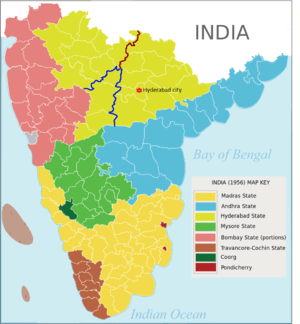
Bombay State
After India's independence, the Deccan States, including Kolhapur, were integrated into Bombay State, which was created from the former Bombay Presidency in 1950.[82] In 1956, the States Reorganisation Act reorganized the Indian states along linguistic lines, and Bombay State was enlarged by the addition of the predominantly Marathi-speaking regions of Marathwada (Aurangabad Division) from erstwhile Hyderabad state and Vidarbha region from the Central Provinces and Berar. The southernmost part of Bombay State was ceded to Mysore.
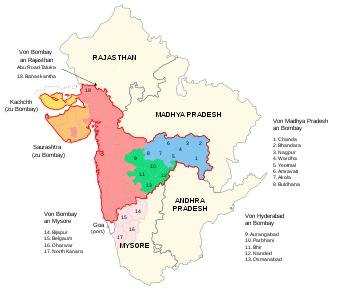
From 1954 to 1955, the people of Marathi speaking areas strongly protested against being included in the bilingual Bombay state. In response, the Samyukta Maharashtra Movement was formed to fight for a united Maharashtra for the Marathi people.[83][84] The Mahagujarat Movement also advocated for a separate Gujarat state. Keshavrao Jedhe, S.M. Joshi, Shripad Amrit Dange, Pralhad Keshav Atre and Gopalrao Khedkar were prominent activists in the campaign to create a separate state of Maharashtra with Mumbai as its capital. On 1 May 1960, following mass protests and 105 deaths, Bombay State was divided into the new states of Maharashtra and Gujarat.[85]
The state continues to have a dispute with Karnataka, to the south, over the regions of Belgaum and Karwar.[86][87][88][89] Some Marathi-majority talukas were also transferred to the Adilabad, Medak, Nizamabad and Mahaboobnagar districts of new Telugu State (now Telangana), to the east of Maharashtra, in 1956.
Maharashtra since 1960
The present state of Maharashtra came into being on 1 May 1960 with Congress party's Yashwantrao Chavan being the first chief minister of the state. The state since its inception has seen huge growth in Industry in a number of areas of the state, increased urbanization, and migration of people from other states India.
Politics
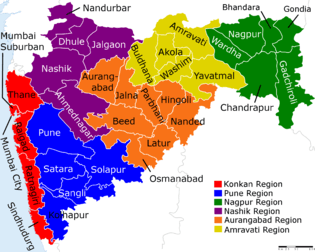
The Congress party and its allies have ruled the state for the major part during the state's existence. After brief reigns by Yashwantrao Chavan, who was inducted as defence minister by Prime minister Nehru, and Marotrao Kannamwar, who died after one year in office, Vasantrao Naik ruled the state as Chief minister from 1963 to 1975.[90] The politics of the state in this period was also dominated leaders such as Yashwantrao Chavan, Vasantdada Patil, Vasantrao Naik, and Shankarrao Chavan.
Sharad Pawar became a significant personality in state in 1978 when he broke away from the Congress party to form an alliance government with the Janata party. During his career, Pawar split Congress twice, with significant consequences for state politics.[91][92] In 1999, after his dispute with the party president Sonia Gandhi over her foreign origins, in 1999, Pawar left the party and formed the Nationalist Congress Party (NCP). The party, however, joined a Congress-led coalition to form the state government after the 1999 Assembly elections.
The Congress party enjoyed a nearly unchallenged dominance of the state political landscape, until 1995 when the coalition of Shiv Sena and the Bharatiya Janata Party (BJP) secured an overwhelming majority in the state, beginning a period of coalition governments.[93] Shiv Sena was the larger party in the coalition. From 1999 until 2014, the NCP and INC formed one coalition while Shiv Sena and the BJP formed another for three successive elections, which the INC-NCP alliance won. Prithviraj Chavan of the Congress party was the last Chief Minister of Maharashtra under the Congress-NCP alliance that ruled until 2014.[94][95][96]
The INC during its rule enjoyed overwhelming support from the state's influential sugar co-operatives, as well as thousands of other cooperatives, such as rural agricultural cooperatives involved in the marketing of dairy and vegetable produce, credit unions, etc.[97]
For the better part of its existence, politics of the state was also dominated by the mainly rural Maratha–Kunbi caste,[98] which accounts for 31% of the population of Maharashtra. They dominated the cooperative institutions; and with the resultant economic power, and controlled politics from the village level up to the Assembly and Lok Sabha.[99][100][101] Major past political figures of the Congress party from Maharashtra—such as Keshavrao Jedhe, Yashwantrao Chavan,[100] Shankarrao Chavan, Vilasrao Deshmukh, and Sharad Pawar—have been from this group. Of the 18 Chief Ministers so far, as many as 10 (55%) have been Maratha.[102] Since the 1980s, this group has also been active in setting up private educational institutions.[103][104][105]
In the 1980s, Shiv Sena and the BJP parties began gaining a foothold in the state especially in the urban areas such as Mumbai. The Shiv Sena was formed in the 1960s by Balashaheb Thackerey, a cartoonist and journalist, to advocate and agitate for the interests of Marathi people in Mumbai. In its early years in the late 1960s, the party specifically targeted immigrants to Mumbai from South India.[106] Over the following decades, the party slowly expanded its base, and took over the then Bombay corporation in the 1980s. The original base of the party was lower middle and working class Marathi people in Mumbai and surrounding urban areas. The leadership of the party came from educated upper caste Maharashtrians. However, since 1990s, strong men have emerged who control their local areas through intimidation and extortion. This has phenomenon has been named "dada-ization" of the party.[107][108] In the early 1990s, some of the party leaders incited violence against Muslims which resulted in riots between Hindus and Muslims.[109] The Shiv Sena and the BJP came into the power at the state level in 1995, which was a big blow to the INC. A split emerged within Shiv Sena when Bal Thackeray anointed his son Uddhav Thackeray as his successor over his nephew Raj Thackeray in 2006. Raj Thackeray then left the party and formed a new party called Maharashtra Navnirman Sena (MNS). Raj Thackeray, like his uncle, also tried to win support from the Marathi community by whipping up anti-immigrant sentiment in Maharashtra, for instance against Biharis and other north Indians.
The BJP is closely related to the RSS and is part of the Sangh Parivar. In early years, the party originally derived its support from the urban upper castes such as Brahmins and non-Maharashtrians. However, in the 21st century, the party was able to penetrate the Maratha group by fielding Maratha candidates in elections.[99]
Economy
Prior to Indian independence, manufacturing industry in what became Maharashtra was based mainly in the city of Mumbai. After the formation of Maharashtra, the state government established the Maharashtra Industrial Development Corporation (MIDC) in 1962 to spur growth in other areas of the state.MIDC in the decades since its formation has acted as the primary industrial infrastructure development agency of the government of Maharashtra. Since its inception, MIDC has established at least one industrial area in every district of the state.[110] The areas with biggest industrial growth were the Pune metropolitan region and areas close to Mumbai such as Thane district and Raigad district.[111] After the 1991 economic liberalization, Maharashtra began to attract foreign capital, particularly in the information technology and engineering industries. The late 1990s and first decade of the 21st century saw huge development in the Information Technology sector, and IT Parks were set up in Aundh, and Hinjewadi areas of Pune.[112]
Maharashtra has hundreds of private colleges and universities, including many religious and special-purpose institutions. Most of the private colleges were set up after the State Government of Vasantdada Patil liberalised the Education Sector in 1982.[113] Politicians and leaders involved in the huge cooperative movement in Maharashtra were instrumental in setting up the private institutes[114][115]
Maharashtra was a pioneer in the development of Agricultural Cooperative Societies after independence. In fact, it was an integral part of the then Governing Congress party's vision of ‘rural development with local initiative’. A ‘special’ status was accorded to the sugar cooperatives and the government assumed the role of a mentor by acting as a stakeholder, guarantor and regulator,[116][117][118] Apart from sugar, Cooperatives played a crucial role in dairy,[119] cotton, and fertiliser industries. Support by the state government led to more than 25,000 cooperatives being set up by 1990s in Maharashtra.[120]
Drought of 1972-73
In 1963, the government of Maharashtra asserted that the agricultural situation in the state was constantly being watched and relief measures were taken as soon as any scarcity was detected. On the basis of this, and asserting that the word famine had now become obsolete in this context, the government passed "The Maharashtra Deletion of the Term 'Famine' Act, 1963".[121] They were unable to foresee the drought in 1972 when 25 million people needed help. The relief measures undertaken by the Government of Maharashtra included employment, programmes aimed at creating productive assets such as tree plantation, conservation of soil, excavation of canals, and building artificial lentic water bodies. The public distribution system distributed food through fair-price shops. No deaths from starvation were reported.[122]
Large scale employment to the deprived sections of Maharashtrian society which attracted considerable amounts of food to Maharashtra.[123] The implementation of the Scarcity Manuals in the state prevented the mortality arising from severe food shortages. The relief works initiated by the government helped employ over 5 million people at the height of the drought in Maharashtra leading to effective famine prevention.[124] The effectiveness of the Maharashtra was also attributable to the direct pressure on the government of Maharashtra by the public who perceived that employment via the relief works programme was their right. The public protested by marching, picketing, and even rioting.Nevertheless, the measures taken by the government were praised for being a model program for famine relief.[125][126]
Farmers' suicides
Since 1990s, there has been a huge increase in number of suicides committed by Farmers in India with Maharashtra accounting for the largest percentage of cases. The main reason cited was their inability to repay loans mostly taken from banks and NBFCs.[127][128][129] Other reasons included the difficulty of farming semi-arid regions, poor agricultural income, absence of alternative income opportunities, and the absence of suitable counselling services.[130][131][132][133][134][135] In 2004, the Mumbai High Court commissioned a report from the Tata Institute on the phenomenon.[136][137] The report cited "government's lack of interest, the absence of a safety net for farmers, and lack of access to information related to agriculture as the chief causes for the desperate condition of farmers in the state."[136]
References
Citations
- Venkatesh, Karthik (5 August 2017). "Konkani vs Marathi: Language battles in golden Goa". LiveMint. Retrieved 29 June 2019.
- Upinder Singh (2008), A History of Ancient and Early Medieval India: From the Stone Age to the 12th Century, p.232
- P. K. Basant (2012), The City and the Country in Early India: A Study of Malwa, pp. 92–96
- Nayanjot Lahiri (5 August 2015). Ashoka in Ancient India. Harvard University Press. p. 82. ISBN 978-0-674-05777-7.
- Singh, Upinder (2008). A History of Ancient and Early Medieval India: From the Stone Age to the 12th Century. Delhi: Pearson Education. pp. 229–233. ISBN 978-81-317-1120-0.
- Margabandhu, C. "Trade Contacts between Western India and the Graeco-Roman World in the early centuries of the Christian era." Journal of the Economic and Social History of the Orient/Journal de l'histoire economique et sociale de l'Orient (1965): 316-322.
- Rath, Jayanti. "QUEENS AND COINS OF INDIA."
- Deo, S. B. "The Genesis of Maharashtra History and Culture." Bulletin of the Deccan College Research Institute 43 (1984): 17-36.
- Journal of the Asiatic Society of Bombay. Asiatic Society of Bombay. 1986. p. 219.
If Konow is right, then the length of time for Ksatrapa rule in the Nasik-Karla-Junnar region would be at least thirty-five years.
- India Today: An Encyclopedia of Life in the Republic: p.440
- Sailendra Nath Sen 1999, pp. 172–176.
- Indian History - page B-57
- A Comprehensive History Of Ancient India (3 Vol. Set): p.203
- The Penguin History of Early India: From the Origins to AD 1300 by Romila Thapar: p.365-366
- Ancient Indian History and Civilization by Sailendra Nath Sen: p.383-384
- Sovani, N.V., 1951. Social Survey Of Kolhapur City Vol. Ii-Industry, Trade And Labour,pp=2-4
- Keay, John (1 May 2001). India: A History. Atlantic Monthly Pr. pp. 252–257. ISBN 978-0-8021-3797-5. The quoted pages can be read at Google Book Search.
- "Nasik District Gazetteer: History – Ancient period". Archived from the original on 7 November 2006. Retrieved 1 October 2006.
- Kulkarni, Chidambara Martanda (1966). Ancient Indian History & Culture. Karnatak Pub. House. p. 233.
- "India 2000 – States and Union Territories of India" (PDF). Indianembassy.org. Retrieved 27 February 2016.
- "Yadav – Pahila Marathi Bana" S.P. Dixit (1962)
- "Marathi - The Language of Warriors". Archived from the original on 21 January 2007. Retrieved 3 January 2007.
- Professor George Moraes. "Pre-Portuguese Culture of Goa". International Goan Convention. Archived from the original on 15 October 2006. Retrieved 1 October 2006.
- Murthy, A. V. Narasimha (1971). The Sevunas of Devagiri. Rao and Raghavan. p. 32.
- Mokashi, Digambar Balkrishna (1 July 1987). Palkhi: An Indian Pilgrimage. SUNY Press. p. 37. ISBN 978-0-88706-461-6.
- "Kingdoms of South Asia – Indian Bahamani Sultanate". The History Files, United Kingdom. Retrieved 12 September 2014.
- Paranjape, Makarand (19 January 2016). Cultural Politics in Modern India: Postcolonial prospects, colourful cosmopolitanism, global proximities. Routledge India. pp. 34, 35. ISBN 978-1138956926.
- Haidar, Navina Najat; Sardar, Marika (27 December 2011). Sultans of the South: Arts of India's Deccan Courts, 1323-1687. Metropolitan Museum of Art. p. 186. ISBN 978-0300175875.
- Satish Chandra (2005). Medieval India: From Sultanat to the Mughals Part - II. Har-Anand Publications. pp. 188–189. ISBN 978-81-241-1066-9.
- Kulkarni, G.T. (1992). "DECCAN (MAHARASHTRA) UNDER THE MUSLIM RULERS FROM KHALJIS TO SHIVAJI : A STUDY IN INTERACTION, PROFESSOR S.M KATRE Felicitation". Bulletin of the Deccan College Research Institute. 51/52: 501–510. JSTOR 42930434.
- Kamat, Jyotsna. "The Adil Shahi Kingdom (1510 CE to 1686 CE)". Kamat's Potpourri. Retrieved 4 December 2014.
- Stewart Gordon (1 February 2007). The Marathas 1600-1818. Cambridge University Press. p. 16. ISBN 978-0-521-03316-9.
- Bhasker Anand Saletore (1934). Social and Political Life in the Vijayanagara Empire (A.D. 1346-A.D. 1646). B.G. Paul.
- Kaushik Roy (3 June 2015). Warfare in Pre-British India - 1500BCE to 1740CE. Routledge. p. 136. ISBN 978-1-317-58692-0.
- A Sketch of the Dynasties of Southern India. E. Keys. 1883. pp. 26–28.
- J.A. Rogers (17 May 2011). World's Great Men of Color, Volume I. Simon and Schuster. pp. 172–174. ISBN 978-1-4516-5054-9.
- "Malik Ambar (1548–1626): the rise and fall of military slavery". British Library. Retrieved 12 September 2014.
- Gordon, The Marathas 1993, pp. 72-102.
- Chary, Manish Telikicherla (2009). India: Nation on the Move: An Overview of India's People, Culture, History, Economy, IT Industry, & More. iUniverse. p. 96. ISBN 978-1440116353.
- Chandorkar, Avinash. "From The Capital Of India To A Divisional Headquarter: Pune's Long Journey". Swarajya. Retrieved 13 January 2018.
- Indu Ramchandani, ed. (2000). Student's Britannica: India (Set of 7 Vols.) 39. Popular Prakashan. p. 8. ISBN 978-0-85229-760-5.
- Haig, Wolseley; Burn, Richard (1962). The Cambridge History of India. CUP Archive. p. 384.
- Marshman, John Clark (18 November 2010). History of India from the Earliest Period to the Close of the East India Company's Government. Cambridge University Press. p. 93. ISBN 9781108021043.
- Shirgaonkar, Varsha S. "Eighteenth Century Deccan: Cultural History of the Peshwas." Aryan Books International, New Delhi (2010). ISBN 978-81-7305-391-7
- Shirgaonkar, Varsha S. "Peshwyanche Vilasi Jeevan." (Luxurious Life of Peshwas) Continental Prakashan, Pune (2012). ISBN 8174210636
- Pearson, M.N. (February 1976). "Shivaji and the Decline of the Mughal Empire". The Journal of Asian Studies. 35 (2): 221–235. doi:10.2307/2053980. JSTOR 2053980.
- Capper, J. (1918). Delhi, the Capital of India. Asian Educational Services. p. 28. ISBN 978-81-206-1282-2. Retrieved 6 January 2017.
- Sen, S.N. (2010). An Advanced History of Modern India. Macmillan India. p. 1941. ISBN 978-0-230-32885-3. Retrieved 6 January 2017.
- Gordon, Stewart (2008). The Marathas 1600-1818 (Digitally print. 1. pbk. version. ed.). Cambridge [u.a.]: Cambridge Univ Pr. pp. 117–121. ISBN 978-0521033169.
- An Advanced History of India, Dr. K.K. Datta, p. 546
- "Forgotten Indian history: The brutal Maratha invasions of Bengal".
- The Rediscovery of India: A New Subcontinent Cite: "Swarming up from the Himalayas, the Marathas now ruled from the Indus and Himalayas in the north to the south tip of the peninsula. They were either masters directly or they took tribute."
- M.A.Ghazi (24 July 2018). Islamic Renaissance In South Asia (1707–1867) : The Role Of Shah Waliallah & His Successors. Adam Publishers & Distributors. ISBN 9788174354006 – via Google Books.
- Mehta (2005), p. 204.
- Sailendra Nath Sen (2010). An Advanced History of Modern India. Macmillan India. p. 16. ISBN 978-0-230-32885-3.
- Bharatiya Vidya Bhavan, Bharatiya Itihasa Samiti, Ramesh Chandra Majumdar – The History and Culture of the Indian People: The Maratha supremacy
- N.G. Rathod (1994). The Great Maratha Mahadaji Scindia. Sarup & Sons. p. 8. ISBN 978-81-85431-52-9.
- Naravane, M.S. (2014). Battles of the Honorourable East India Company. A.P.H. Publishing Corporation. p. 63. ISBN 978-81-313-0034-3.
- 280 years ago, Baroda had its own Navy. Times of India.
- Sridharan, K (2000). Sea: Our Saviour. New Age International (P) Ltd. ISBN 978-81-224-1245-1.
- Sharma, Yogesh (2010). Coastal Histories: Society and Ecology in Pre-modern India. Primus Books. p. 66. ISBN 978-93-80607-00-9.
- Wink, A., 1983. Maratha revenue farming. Modern Asian Studies, 17(04), pp.591-628.
- Omvedt, G.in 1973. Development of the Maharashtrian Class Structure, 1818 to 1931. Economic and Political Weekly, pp.1417-1432..
- Molesworth, James; Candy, Thomas; Narayan G Kalelkar (1857). Molesworth's Marathi-English dictionary (2nd ed.). Pune: J.C. Furla, Shubhada Saraswat Prakashan. ISBN 978-81-86411-57-5.
- Molesworth, J. T. (James Thomas) (1857). "A dictionary, Marathi and English. 2d ed., rev. and enl". dsal.uchicago.edu. Retrieved 29 June 2019.
- Chavan, Dilip (2013). Language politics under colonialism : caste, class and language pedagogy in western India (first ed.). Newcastle upon Tyne: Cambridge Scholars. pp. 136–184. ISBN 978-1443842501. Retrieved 13 December 2016.,
- Natarajan, Nalini (editor); Deo, Shripad D. (1996). Handbook of twentieth century literatures of India (1. publ. ed.). Westport, Conn. [u.a.]: Greenwood Press. p. 212. ISBN 978-0313287787.CS1 maint: extra text: authors list (link)
- Johnson, Gordon (1973). Provincial Politics and Indian nationalism : Bombay and the Indian National Congress, 1880 - 1915. Cambridge: Univ. Press. p. 92. ISBN 978-0521202596. Retrieved 20 September 2016.
- Roy, edited by Ramashray (2007). India's 2004 elections : grass-roots and national perspectives (1. publ. ed.). New Delhi [u.a.]: Sage. p. 87. ISBN 9780761935162. Retrieved 8 September 2016.CS1 maint: extra text: authors list (link)
- Kosambi, Meera (Editor); Lane, James (Author) (2000). Intersections : socio-cultural trends in Maharashtra, Chapter 3, A Question of Maharashtrian identity. London: Sangam. pp. 59–70. ISBN 9780863118241.CS1 maint: extra text: authors list (link)
- Ramachandra Guha, "The Other Liberal Light," New Republic 22 June 2012
- Hansen, Thomas Blom (2002). Wages of violence : naming and identity in postcolonial Bombay. Princeton, N.J.: Princeton University Press. p. 33. ISBN 978-0691088402. Retrieved 10 January 2017.
- Omvedt, G., 1973. Non-Brahmans and Communists in Bombay. Economic and Political Weekly, pp.749-759.
- Omvedt, Gail (1974). "Non-Brahmans and Nationalists in Poona". Economic and Political Weekly. 9 (6/8): 201–219. JSTOR 4363419.
- Shastree, Uttara (1996). Religious Converts in India: Socio-political Study of Neo-Buddhists. Mittal Publications. pp. 1–20. ISBN 9788170996293.
- "Some Facts of Constituent Assembly". 11 May 2011. Archived from the original on 11 May 2011. Retrieved 30 July 2019.
On 29 August 1947, the Constituent Assembly set up a Drafting Committee under the Chairmanship of Dr. B.R. Ambedkar to prepare a Draft Constitution for India.
- Majumdar, Sumit K. (2012), India's Late, Late Industrial Revolution: Democratizing Entrepreneurship, Cambridge: Cambridge University Press, ISBN 1-107-01500-6, retrieved 2013-12-07
- Lacina, Bethany Ann (2017). Rival Claims: Ethnic Violence and Territorial Autonomy Under Indian Federalism. Ann arbor, MI, USA: University of Michigan press. p. 129. ISBN 978-0472130245.
- Morris, David (1965). Emergence of an Industrial Labor Force in India: A Study of the Bombay Cotton Mills, 1854-1947. University of California Press. p. 63. ISBN 9780520008854.
konkan.
- Chandavarkar, Rajnarayan (2002). The origins of industrial capitalism in India business strategies and the working classes in Bombay, 1900-1940 (1st pbk. ed.). Cambridge [England]: Cambridge University Press. p. 33. ISBN 9780521525954.
- Gugler, edited by Josef (2004). World cities beyond the West : globalization, development, and inequality (Repr. ed.). Cambridge: Cambridge University Press. p. 334. ISBN 9780521830034.CS1 maint: extra text: authors list (link)
- "History of Kolhapur City". Kolhapur Corporation. Retrieved 12 September 2014.
- Radheshyam Jadhav (30 April 2010). "Samyukta Maharashtra movement". The Times of India. The Times Group. Bennet, Coleman & Co. Ltd. Retrieved 12 September 2014.
- "The Samyukta Maharashtra movement". Daily News and Analysis. Dainik Bhaskar Group. Diligent Media Corporation. 1 May 2014. Retrieved 12 September 2014.
- Bhagwat, Ramu (3 August 2013). "Linguistic states". The Times of India. The Times Group. Bennet, Coleman & Co. Ltd. Retrieved 12 September 2014.
- Banerjee, S (1997). "The Saffron Wave: The Eleventh General Elections in Maharashtra". Economic and Political Weekly. 32 (40): 2551–2560. JSTOR 4405925.
- Sirsikar, V.M. (1966). Politics in Maharashtra, Problems and Prospects (PDF). Poona: University of Poona. p. 8.
- "Belgaum border dispute". Deccan Chronicle. Deccan Chronicle Holdings Limited. 30 July 2014. Retrieved 12 September 2014.
- "The States Reorganisation Act, 1956". Indiankanoon.org. Retrieved 27 February 2016.
- Brass, Paul R. (2006). The politics of India since independence (2nd ed.). [New Delhi]: Cambridge University Press. p. 127. ISBN 978-0521543057. Retrieved 1 February 2017.
- Wilkinson, Steven (January 2005). "Elections in India: Behind the Congress Comeback". Journal of Democracy. 16 (1): 153–167. doi:10.1353/jod.2005.0018.
- Kamat, AR (October 1980). "Politico-economic developments in Maharashtra: a review of the post-independence period, - JSTOR". Economic and Political Weekly. 15 (40): 1669–1678. JSTOR 4369147.
- Palshikar, S; Birmal, N (18 December 2004). "Maharashtra: Towards a New Party System". Economic and Political Weekly. 39 (51): 5467–5472. JSTOR 4415934.
- "Clean yet invisible: Prithviraj Chavan quits as CM, did anyone notice?". Firstpost. 27 September 2014. Retrieved 29 September 2014.
- "Maharashtra CM Prithviraj Chavan's rivals get key posts for Assembly polls". India Today. 16 August 2014. Retrieved 29 September 2014.
- "Right man in the wrong polity". Tehelka. 28 April 2012. Archived from the original on 6 October 2014. Retrieved 29 September 2014.
- Brass, Paul R. (2006). The politics of India since independence (2nd ed.). [New Delhi]: Cambridge University Press. p. 142. ISBN 978-0521543057. Retrieved 1 February 2017.
- Mishra, Sumita (2000). Grassroot politics in India. New Delhi: Mittal Publications. p. 27. ISBN 9788170997320.
- Vora, Rajendra (2009). "Chapter 7 Maharashtra or Maratha Rashtra". In Kumar, Sanjay; Jaffrelot, Christophe (eds.). Rise of the plebeians? : the changing face of Indian legislative assemblies. New Delhi: Routledge. ISBN 978-0415460927.
- Kulkarni, A.R. (Editor); Wagle, N.K.(Editor); Sirsikar, V.M. (Author) (1999). State intervention and popular response : western India in the nineteenth century. Mumbai: Popular Prakashan. p. 9. ISBN 978-81-7154-835-4.CS1 maint: extra text: authors list (link)
- "Maratha morcha: Over 150 MLAs, MLCs set to join the march in Nagpur on Wednesday". Firstpost. 13 December 2016. Retrieved 27 October 2017.
- Kakodkar, Priyanka (1 July 2014). "A quota for the ruling class". The Hindu. Retrieved 27 October 2017.
- Dahiwale, S. M. (1995). "Consolidation of Maratha Dominance in Maharashtra Economic and Political Weekly Vol. 30, No. 6 (Feb. 11, 1995), pp. 336-342 Published by". Economic and Political Weekly. 30 (6): 336–342. JSTOR 4402382.
- Kurtz, Donald V. (1994). Contradictions and conflict : a dialectical political anthropology of a University in Western India. Leiden [u.a.]: Brill. p. 50. ISBN 978-9004098282.
- Singh, R.; Lele, J.K. (1989). Language and society : steps towards an integrated theory. Leiden: E.J. Brill. pp. 32–42. ISBN 9789004087897.
- Subramanian, R.R., A Tale of Two Cities: Reconstructing the ‘Bajao Pungi, Hatao Lungi’campaign in Bombay, and the Birth of the ‘Other’. Editorial Note, p.37.
- Thomas Blom Hansen (5 June 2018). Wages of Violence: Naming and Identity in Postcolonial Bombay. Princeton University Press. pp. 102–103. ISBN 978-0-691-18862-1.
- Christophe Jaffrelot; Sanjay Kumar (4 May 2012). Rise of the Plebeians?: The Changing Face of the Indian Legislative Assemblies. Routledge. pp. 240–. ISBN 978-1-136-51662-7.
- "Shiv Sena politician convicted over 1992 Mumbai riots". Reuters. 9 July 2008.
- Anand, V., 2004. Multi-party accountability for environmentally sustainable industrial development: the challenge of active citizenship. PRIA Study Report, No. 4, March, 04.
- Menon, Sudha (30 March 2002). "Pimpri-Chinchwad industrial belt: Placing Pune at the front". The Hindu Business Line. Retrieved 29 January 2012.
- Heitzman, James (2008). The city in South Asia. London: Routledge. p. 218. ISBN 978-0415574266. Retrieved 14 November 2016.
pune.
- Bhosale, Jayashree (10 November 2007). "Economic Times: Despite private participation Education lacks quality in Maharashtra". Archived from the original on 10 October 2014. Retrieved 6 October 2014.
- Dahiwale Vol. 30, No. 6 (Feb. 11, 1995), pp., S. M. (1995). "Consolidation of Maratha Dominance in Maharashtra". Economic and Political Weekly. 30 (6): 341–342. JSTOR 4402382.CS1 maint: multiple names: authors list (link)
- Baviskar, B. S. (2007). "Cooperatives in Maharashtra: Challenges Ahead". Economic and Political Weekly. 42 (42): 4217–4219. JSTOR 40276570.
- Lalvani, Mala (2008). "Sugar Co-operatives in Maharashtra: A Political Economy Perspective". The Journal of Development Studies. 44 (10): 1474–1505. doi:10.1080/00220380802265108.
- Patil, Anil (9 July 2007). "Sugar cooperatives on death bed in Maharashtra". Rediff India. Archived from the original on 28 August 2011. Retrieved 27 December 2011.
- Banishree Das; Nirod Kumar Palai & Kumar Das (18 July 2006). "Problems and Prospects of the Cooperative Movement in India Under the Globalization Regime" (PDF). XIV International Economic History Congress, Helsinki 2006, Session 72. Archived (PDF) from the original on 24 September 2015. Retrieved 28 September 2015.
- "Mahanand Dairy". Archived from the original on 24 November 2014. Retrieved 28 September 2014.
- Dahiwale, S. M. (11 February 1995). "Consolidation of Maratha Dominance in Maharashtra". Economic and Political Weekly. 30 (6): 340–342. JSTOR 4402382.
- Sainath 2010, p. 1.
- American Association for the Advancement of Science et al. 1989, pp. 379.
- Drèze 1991, p. 89.
- Waal 1997, p. 15.
- Drèze 1991, pp. 92–93.
- Drèze 1991, pp. 93.
- [ncrb.gov.in "NCRB"] Check
|url=value (help). Official website. Government of India. Retrieved 25 March 2019. - NCRB report - farmers suicides (PDF). NCRB / Government of India. Retrieved 25 March 2019.
- "In 80% farmer-suicides due to debt, loans from banks, not moneylenders". The Indian Express. Retrieved 25 March 2019.
- Gruère, G. & Sengupta, D. (2011), Bt cotton and farmer suicides in India: an evidence-based assessment, The Journal of Development Studies, 47(2), 316–337
- Schurman, R. (2013), Shadow space: suicides and the predicament of rural India, Journal of Peasant Studies, 40(3), 597–601
- Das, A. (2011), Farmers’ suicide in India: implications for public mental health, International Journal of Social Psychiatry, 57(1), 21–29
- Mishra, Srijit (2007). "Risks, Farmers' Suicides and Agrarian Crisis in India: Is There A Way Out?" (PDF). Indira Gandhi Institute of Development Research (IGIDR).
- Guillaume P. Gruère, Purvi Mehta-Bhatt and Debdatta Sengupta (2008). "Bt Cotton and Farmer Suicides in India: Reviewing the Evidence" (PDF). International Food Policy Research Institute.
- Nagraj, K. (2008). "Farmers suicide in India: magnitudes, trends and spatial patterns" (PDF). Archived from the original (PDF) on 12 May 2011.
- Staff, InfoChange August 2005. 644 farmer suicides in Maharashtra since 2001, says TISS report
- Dandekar A, et al, Tata Institute. Causes of Farmer Suicides in Maharashtra: An Enquiry. Final Report Submitted to the Mumbai High Court 15 March 2005 Archived 9 August 2013 at the Wayback Machine
Bibliography
- महाराष्ट्राचा गौरवशाली इतिहास / The History of Maharashtra.....
- James Grant Duff, History of the Mahrattas, 3 vols. London, Longmans, Rees, Orme, Brown, and Green (1826). ISBN 81-7020-956-0
- Mahadev Govind Ranade, Rise of the Maratha Power (1900); reprint (1999). ISBN 81-7117-181-8
- Richard Eaton, The new Cambridge history of India,[1]
- Sailendra Nath Sen (1999). Ancient Indian History and Civilization. New Age International. ISBN 9788122411980.CS1 maint: ref=harv (link)
External links
- Eaton, Richard M. (2005). The new Cambridge history of India (1. publ. ed.). Cambridge: Cambridge University Press. p. 154. ISBN 978-0-521-25484-7. Retrieved 25 March 2016.
